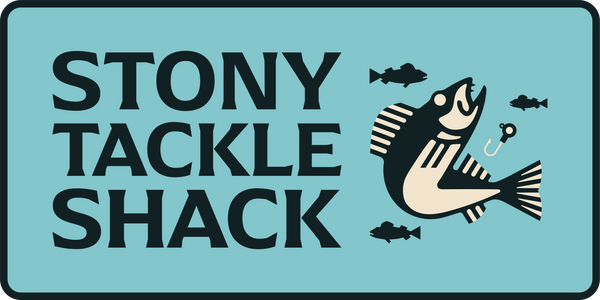
Walking on Water (Solid Water, That Is): A Guide to Ice Fishing Safety
At Stony Tackle Shack, we believe in ice safety and think everyone should be educated in it before hitting the hard water.
Ice fishing. The quiet solitude, the thrill of the bite, the camaraderie around a hole in the ice. It's a fantastic winter pastime, but it's crucial to remember one thing above all else: safety. A successful ice fishing trip starts long before you drill that first hole. This blog post will cover essential safety tips to ensure your outing is enjoyable and, most importantly, safe.
Know Before You Go: Ice Conditions are Key
The most critical factor in ice fishing safety is the ice itself. Never assume ice is safe, even if others are out on it. Conditions can change rapidly due to fluctuating temperatures, snow cover, and underlying water currents.
- Check, Check, and Check Again: Don't rely on someone else's assessment. Before venturing out, check ice thickness yourself using an ice chisel or auger. New, clear ice is the strongest. Avoid areas with cracks, slush, or discoloration, as these indicate weaker spots.
- The "Thumb Rule" is a Good Start, But Not the Whole Story: While the general guideline of 4 inches of solid ice for walking, 5-7 inches for ATVs or snowmobiles, and 8-12 inches for cars and small trucks is a good starting point, it's not foolproof. Ice strength can vary significantly even within a small area. Always err on the side of caution.
- Be Aware of Your Surroundings: Stay away from moving water like rivers and streams, as ice near these areas is often weaker. Also, avoid areas around docks, bridges, and shorelines, where ice may be thinner.
Gear Up for Safety:
Having the right equipment can make all the difference in an emergency.
- Ice Picks: These are essential for self-rescue if you fall through the ice. Wear them around your neck and make sure they are easily accessible.
- Rope: A length of rope can be used to help rescue someone who has fallen through the ice or to pull yourself to safety.
- Floatation Device: Wear a life jacket or float suit. This will keep you afloat if you fall in, giving you a chance to self-rescue or be rescued.
- Ice Chisel or Auger: Use these to regularly check ice thickness as you move around.
- First-Aid Kit: Carry a well-stocked first-aid kit for minor injuries.
- Whistle: A whistle can be used to signal for help in an emergency.
- Cell Phone (in a waterproof bag): While not always reliable in remote areas, a cell phone can be used to call for help if you have service. Consider a satellite communication device for remote locations.
Smart Practices on the Ice:
- Never Fish Alone: Always go with a friend or group. Let someone know your plans and expected return time.
- Stay Sober: Alcohol impairs judgment and slows reaction time, making it a dangerous combination with ice fishing.
- Keep a Safe Distance: Don't crowd other anglers. Maintain a safe distance between holes to avoid weakening the ice.
- Watch for Changes: Be vigilant about changes in ice conditions throughout the day. Cracking sounds or the appearance of slush are warning signs to leave the ice immediately.
- Know What to Do if You Fall Through: Practice self-rescue techniques. The key is to stay calm, use your ice picks to pull yourself onto the ice, and roll away from the hole.
Respect the Ice, Respect Yourself:
Ice fishing can be a thrilling experience, but it's crucial to approach it with respect and caution. By following these safety tips, you can minimize the risks and enjoy a safe and successful time on the ice. Remember, no fish is worth risking your life. When in doubt, stay off the ice. Your safety is paramount.
WWW.STONYTACKLESHACK.CA
